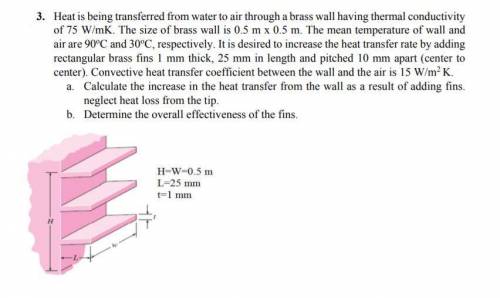
Engineering, 05.12.2021 17:20 saniyawilliams1207
Heat is being transferred from water to air through a brass wall having thermal conductivity of 75 W/mK. The size of brass wall is 0.5 m x 0.5 m. The mean temperature of wall and air are 90C and 30C, respectively. It is desired to increase the heat transfer rate by adding rectangular brass fins 1 mm thick, 25 mm in length and pitched 10 mm apart (center to center). Convective heat transfer coefficient between the wall and the air is 15 W/m2 K.
a. Calculate the increase in the heat transfer from the wall as a result of adding fins.
neglect heat loss from the tip.
b. Determine the overall effectiveness of the fins.


Answers: 3


Another question on Engineering

Engineering, 04.07.2019 18:10
Aplate clutch has a single pair of mating friction surfaces 250-mm od by 175-mm id. the mean value of the coefficient of friction is 0.30, and the actuating force is 4 kn. a) find the maximum pressure and the torque capacity using the uniform-wear model. b) find the maximum pressure and the torque capacity using the uniform-pressure model.
Answers: 3

Engineering, 04.07.2019 18:10
Journeyman training is usually related (clo2) a)-to specific tasks b)-to cost analysis of maintenance task c)-to control process to ensure quality d)-to installation of machinery
Answers: 2

Engineering, 04.07.2019 18:20
Describe one experiment in which the glass transition temperature and melting temperature of a totally amorphous thermoplastic material can be determined. show the relevant experimental results in a diagram which should be properly annotated with the two temperatures clearly marked. what is likely to happen to the curve in the diagram if the amorphous polymer is replaced by a thermosetting type?
Answers: 2

Engineering, 04.07.2019 18:20
An open feedwater heater operates at steady state with liquid entering at inlet 1 with t? = 40°c and pl = 1 .2 mpa. water vapor att2-200°c and p2 = 1.2 mpa enters at inlet 2. saturated liquid water exits with a pressure of pa 1.2 mpa. neglect heat transfer with the surroundings and all kinetic and potential energy effects, determine the mass flow rate of steam at inlet 2 if the mass flow rate of liquid water at inlet 1 is given as 2 kg/s.
Answers: 3
You know the right answer?
Heat is being transferred from water to air through a brass wall having thermal conductivity of 75 W...
Questions



Advanced Placement (AP), 30.10.2019 22:31














English, 30.10.2019 22:31





